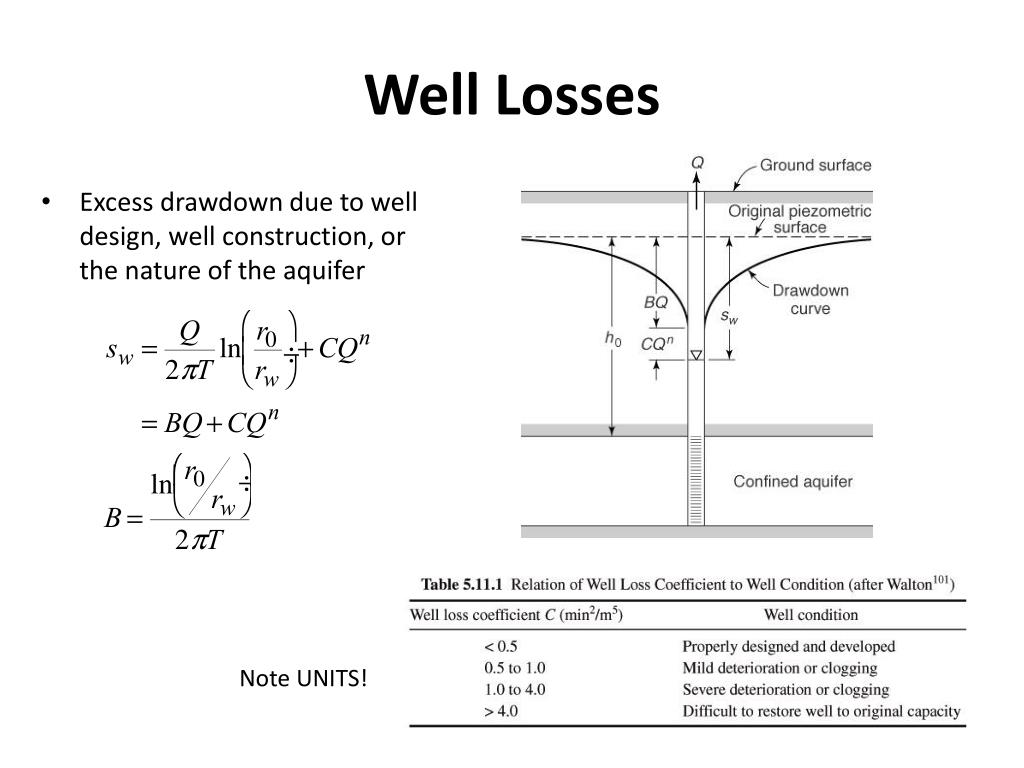


A New Productivity Index Formula for ESP-Lifted Wells. The equilibrium equations, which yield values of permeability and transmissivity, are used for the analysis of discharging well tests. Productivity Index Prediction for Oil Horizontal Wells Using different Artificial Intelligence Techniques. WorldCat Noteworthy papers in OnePetroĪlarifi, S., AlNuaim, S., & Abdulraheem, A. This is why thinly saturated zones are unsuitable for high volume pumping even if substantial water is present - the saturated thickness must be large enough so that the pump can remain completely submerged at maximum drawdown. This same concept can be applied to injection wells to calculate an injectivity index (II), using the same equations.ġ. This lowering of the water table is known as drawdown, and may amount to many tens of feet (see figure 1 below). This approach is less common, as the production and pressure data are more readily available, and in most cases can be more accurately measured.
#Well drawdown formula skin
K = permeability, md h = net thickness, ft u = fluid viscosity, cp B = formation volume factor, rb/STB re = external boundary radius, ft rw = wellbore radius, ft S = Skin The productivity index can also be expanded to a semi-steady state Darcy law type formulation where: The difference (Pe - Pw) is called the pressure drawdown.Įxample 2: Q = 500 STB/D Pe= 3000 psi Pwf = 250 psi and the well discharge rate Q is a constant, the solution, in terms of the drawdown s: sH0H. J = Productivity Index, STB/day/psi Q = Surface flowrate at standard conditions, STB/D Pe = External boundary radius pressure, psi Pwf = Well sand-face mid-perf pressure, psiĪ well is producing 1000 STB/D of liquid with a pressure drop of 500 psi would have a J=2 STB/D/psi.Ī subsurface pressure gauge is used to determine the static pressure Pe after a sufficient shut-in period and also the flowing bottom-hole pressure, Pw, after the well has flowed at a stabilized rate for a sufficient period of time.

The units typically are in field units, STB/D/psi as shown below: forgetting to keep units consistent (i.e.The productivity index is the ratio of the total liquid surface flowrate to the pressure drawdown at the midpoint of the producing interval. What would be a common error in this example? The results should look as follows (with units of m-d): The test will run for 1 day, and monitoring will occur approximately every 3 hours. With a pumping rate of 2730 m 3/d, what would be the expected drawdown at a monitoring well 122 m away. The intention of the upcoming pump test is to double check these estimates. The calculated drawdown is that in the piezometer, not that in the pumping well. To analyze the data, s is plotted on the logarithmic Y axis and time is plotted on the linear X axis as the ratio of t/t (total time since pumping began divided by the time since the pumping ceased). They have results from a pump test conducted two decades earlier, indicating a transmissivity of 1250 m 2/d and a storage coefficient of 1.9x10 -4. The aquifer is both homogeneous and isotropic.

Your browser does not support inline frames or is currently configured not to display inline frames.Ī consultant is preparing to conduct a pump test at a local well field. T (elapsed time since the start of pumping): Drawdown + Static Water Level Pumping Water Level 30 ft + 20 ft 50 ft Pumping Water Level Drawdown Static Water Level 50 ft 30 ft 20 ft Since static and pumping water levels are field measurements, drawdown is typically the calculated value. The Cooper-Jacob approximation is given by: This calculator is good for anticipating results from pump tests. The Cooper-Jacob calculator presented here estimates the drawdown for a given well location over time. COOPER-JACOB APPROXIMATION An approximation of the Theissian Model for Pumping Test Interpretation Back to CalculatorsĬooper and Jacob (1946) developed an approximation for the Theis equation and a data analysis method which does not require type-curve matching.


 0 kommentar(er)
0 kommentar(er)
